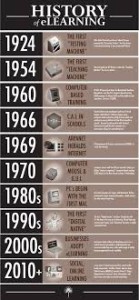History of eLearning & Interactive Books
In the early 1960s Stanford University psychology professors Patrick Suppes and Richard C. Atkinson experimented with using computers to teach math and reading to young children in elementary schools in East Palo Alto, California. Stanford’s Educational Program for Gifted Youth is descended from those early experiments.
In 1963, Bernard Luskin installed the first computer in a community college for instruction, working with Stanford and others, developed computer assisted instruction. Luskin completed his landmark UCLA dissertation working with the Rand Corporation in analyzing obstacles to computer assisted instruction in 1970.
Early e-learning systems, based on Computer-Based Learning/Training often attempted to replicate autocratic teaching styles whereby the role of the e-learning system was assumed to be for transferring knowledge, as opposed to systems developed later based on Computer Supported Collaborative Learning (CSCL), which encouraged the shared development of knowledge.
As early as 1993, William D. Graziadei described an online computer-delivered lecture, tutorial and assessment project using electronic mail. By 1994, the first on line high school had been founded.
In 1997 Graziadei, W.D., et al, published an article entitled “Building Asynchronous and Synchronous (asynchronous learning uses online learning resources and is a state of not being synchronized whereas synchronous is the synchronized coordination of events to operate a system in unison without the random results of online learning resources) Teaching-Learning Environments: Exploring a Course/Classroom Management System Solution.” They described a process at the State University of New York (SUNY) of evaluating products and developing an overall strategy for technology-based course development and management in teaching-learning. The product(s) had to be easy to use and maintain, portable, replicable, scalable, and immediately affordable, and they had to have a high probability of success with long-term cost-effectiveness.
INTERACTIVE BOOKS
It’s not a question of if it’s a question of when. It has been estimated that eBooks will supplant traditional textbooks within 5-7 years. eBooks, also known as “techbook,” contains a large collection of online learning tools and games ranging from videos, quizzes, animations, simulations, and puzzles, all aligned to standards, made completely searchable, and organized into a complete curriculum. In a recent report by State Educational Technology Directors Association (SETDA) they stated the benefits for student learning were many.
a recent report by State Educational Technology Directors Association (SETDA) they stated the benefits for student learning were many.
“Digital content can easily be kept up to date and relevant to students’ lives without the cost of reprinting or redistributing print materials such as a textbook. It can be made available anytime and anywhere, both online and offline, and accessible when and where the student, teacher, or parent needs it. It can be personalized to individual student learning needs and abilities. And, digital content can be far richer and engaging, including not only text, but also high-definition graphics, video clips animations, simulations, interactive lessons, virtual labs, and online assessments. Instead of fitting students to content, digital content allows the teacher to fit the content to the student.”

Recent Comments